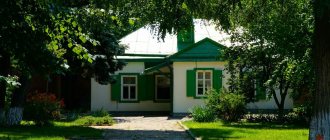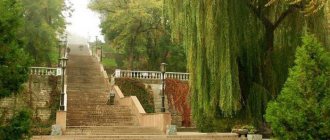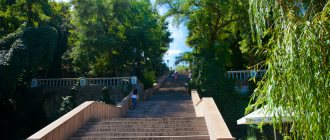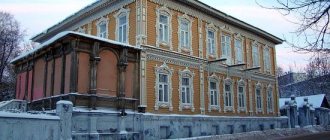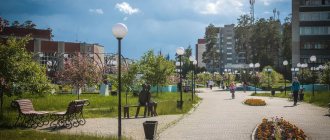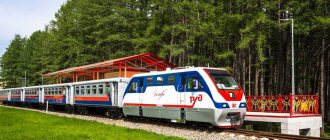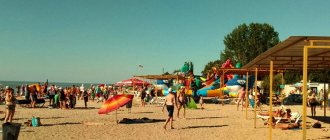Taganrog is a port city founded in 1698 by Peter the Great. The name of the city comes from the name of the cape on which it is built - Taganiy Rog.
Anton Pavlovich Chekhov and Faina Ranevskaya were born and raised in Taganrog, and circus artist Anatoly Durov Jr. lived. Taganrog is called a museum city thanks to its noble mansions, merchant estates and churches of the 19th century.
What interesting things are worth seeing around Taganrog - in the overview of the sights of the Rostov region.
If you pass Rostov-on-Don on your way to Taganrog, read our article about the most interesting places in this city.
For ease of route planning, we have marked all the mentioned attractions on the city map:
Historical sites and museums
Museum "Chekhov's House"
Address: st. Chekhova, 69 Phone: Social networks: https://vk.com/tgliamz Opening hours: daily 10-00 – 17-00 Cost: entrance for an adult 80 rubles, for a student 50 rubles, for a schoolchild 40 rubles.
The outbuilding, where the famous Russian writer Anton Pavlovich Chekhov was once born, is now equipped as the Chekhov's House museum. It has several rooms: kitchen, living room, bedroom, children's room. Belongings of the Chekhov family and household items of that time are exhibited.
The family lived in the house for only 2 years (1859-1861). At the beginning of the 20th century, the building was bought and a museum was installed in it. The exhibition was first opened in 1926.
Not far from the outbuilding is another Chekhov museum. It is located in a former wine shop (at 100 Aleksandrovskaya St.). The writer’s father, merchant of the first guild Pavel Egorovich Chekhov, worked here.
Alferaki Palace
Address: st. Frunze, 41 Phone: , Website: https://www.tgliamz.ru/visitors/room3.php Opening hours: Tue-Sun 10-00 - 18-00, Mon - closed Cost: entrance for adults 100 rubles, for student 50 rub., for schoolchild 40 rub.
Alferaki Palace is part of the Taganrog Historical and Cultural Museum-Reserve. Named after the owner of the estate who built the palace - landowner, rich man and large merchant, Nikolai Dmitrievich Alferaki.
The palace building was built in 1848 by the architect Andrei Ivanovich Stackenschneider (St. Petersburg). The style is neo-baroque and imitation of Greek motifs (Alferaki is Greek by origin). The interior is decorated with secular frescoes.
In the 19th century, balls were held in the palace. After the death of N.D. Alferaki, when the estate was sold, the merchant community organized social concerts and commercial meetings here. Since 1927, the palace has become a museum.
Taganrog Art Museum
Address: st. Aleksandrovskaya, 56 Phones: (director), 8 (8634) 38-32-86 (accounting) Website: https://www.artmuseumtgn.ru/ Opening hours: Tue-Sun 10-00 – 18-00, closed Mon , the last Friday of each month is a sanitary day. Cost: admission for adults from 30 to 150 rubles, for students from 20 to 120 rubles, for schoolchildren from 20 to 70 rubles.
The museum was founded in 1848 as an art exhibition at the Museum of Local History on the initiative of Chekhov and Repin.
Since 1968, the collection has become an independent Art Museum. Today it is located in the estate of the merchant of the second guild A.Z. Khandrina, who in 1909-1913 served as the mayor of the city of Taganrog.
The modern museum collection exhibits paintings by Russian artists of the 18th and 19th centuries. Among them are masterpieces by Savitsky, Savrasov, Kuindzhi, Makovsky, Aivazovsky, Serov, Repin, Korovin, Tropinin, Surikov, Shishkin, Levitan.
In the courtyard of the museum there is an open-air exhibition of ancient cemetery sculptures.
Museum of Urban Planning and Life
Address: st. Frunze, 80 Phone: Website: https://tgliamz.ru/visitors/room1.php Opening hours: Tue-Sun 10-00 – 18-00, closed Mon Cost: entrance for adults 80 rubles, for students 50 rubles. , for a schoolchild 40 rubles.
The museum's collection is located in an ancient building built in 1912, the former mansion of grain merchant Yevgeny Ivanovich Sharonov.
The architect of the mansion is Fyodor Osipovich Shekhtel, who also designed the Yaroslavsky railway station in Moscow, the chapel at St. Michael's Church (in Taganrog) and the chapel at the Cathedral of Saints Peter and Paul (in Moscow). Viktor Vasnetsov and Mikhail Vrubel worked on the decoration of the external walls of the manor house.
The modern exhibition of the museum shows the history of the development of furniture and interior decor. Typical furniture of the 18th-20th centuries is exhibited here, as well as examples of furnishing rooms of representatives of different classes and professions. 4 halls of the history of urban planning were opened, the hall of Faina Ranevskaya, a native of Taganrog. There is a collection of glass products.
Literary Museum of A.P. Chekhov
Address: st. Oktyabrskaya, 9 Phone: , Website: https://www.tgliamz.ru/visitors/room4.php Opening hours: Tue-Sun 10-00 - 17-00, Mon - closed Cost: entrance for adults 100 rubles, for student 60 rub., for schoolchild 50 rub.
The museum is located in the building of the former men's gymnasium, where in 1868-1879. Russian writer Chekhov studied.
The museum exhibition is dedicated to the life of Chekhov and his work. Chekhov Gymnasium is one of the oldest schools in Russia. Founded in 1806, it was located in the house of the mayor of Campenhausen and only in 1843 moved to a new building.
Museum of Faina Ranevskaya
Address: st. Frunze, 10
The museum has been planned to open for 30 years. The idea of the museum was first expressed by Innokenty Smoktunovsky in 1987. Today the building is occupied by residential apartments.
On the street next to the house there is a sculpture of Faina Ranevskaya in the image of Lyalya, with an umbrella.
Museum of A. A. Durov
Address: per. A. Glushko, 44 st. Frunze, 80 Phone: Website: https://www.museum.ru/M871 Opening hours: Tue-Sun 10-00 - 18-00, Mon - closed Cost: entrance for adults 80 rubles, for students and schoolchildren 40 rubles .
The Museum of Circus Art was opened in 1988. The museum's exhibition is dedicated to the life of Anatoly Anatolyevich Durov (known as Durov Jr.), a representative of the Durov circus dynasty. The modern museum is located in one of the buildings purchased by Durov.
Among the exhibits of the museum exhibition: stuffed animals, family photographs, old circus posters, costumes, and a stylized arena. As well as stands with photographs of performances by other representatives of the circus dynasty.
Old station - Taganrog-2 station and monument to the steam locomotive
Address: pl. Vosstaniya, 1
The first Taganrog station was built in 1862 by the architect Zagoskin. Today it serves as a secondary suburban station.
An old steam locomotive is installed nearby - a monument to the heroic railway workers who died here in battle with the White Guards. Taganrog drivers directed the locomotive to the station building, where the headquarters of the White Guard was located.
The station is located in the historical part of Taganrog. 200 m from it is the Museum of Urban Planning, the house of Faina Ranevskaya, 600 m from the Museum “Chekhov’s Shop”.
Taganrog Museum of Aviation Technology
Address: st. Tsiolkovskogo, 42, Aerodrom-Tsentralny Telephone: Opening hours: Mon-Fri 8-00 – 14-00 Cost: entrance and excursion (2 hours) – 75 rubles.
The museum is located on the territory of a military unit, access to the museum is through the checkpoint at the Airplane monument on the street. Tsiolkovsky.
The Museum of Aviation Technology arose on the territory of an aircraft repair plant, next to the airfield. Here, in accordance with the Treaty on the Armed Forces of Europe, military aircraft were disposed of. Some of them, after removing the engines and combat systems, were left as museum exhibits in Taganrog.
The modern museum displays 12 types of aircraft. Among them:
- vertical take-off attack aircraft Yak-38;
- Su-7 fighter-bomber;
- the first supersonic fighter of the union, MiG-19;
- MiG-21 and MiG-23 fighters that fought in Afghanistan;
- supersonic interceptor MiG-25;
- Be-12 amphibious aircraft;
- Czechoslovak training aircraft L-29 and L-39.
And also the AN-2 maize truck, helicopters, aviation equipment - catapults, rockets, guns, bombs.
Sights of Taganrog: TOP-5
Any sightseeing tour begins with a visit to interesting places in Taganrog, which are considered its calling cards. Images of these iconic landmarks adorn presentation products telling the story of the city.
Stone staircase
- Address: recreation between Portovaya and Grecheskaya streets. Transport stop "Turgenevsky Lane" or "Pushkinskaya Embankment".
For more than a century, the majestic building has been considered one of the main symbols of Taganrog. Kerch and Nizhny Novgorod can also boast of attractions of this kind . The structure, whose construction was completed in 1823, has a length of 108 m and a width of 6.5 m. 188 granite steps of the staircase, decorated with Sarmatian stone, separate 13 platforms. In several places, observation platforms extend from the central promenade, surrounded by balustrades, where benches for rest are installed. Retro lights are installed on special pylons along the entire descent.
Sharonov's House
- Opening hours: daily, from 10:00 to 18:00.
- Ticket price: adult 80 rub., student 50 rub., for schoolchildren 40 rub.
- Telephone.
- Website: https://www.tgliamz.ru/visitors/room1.php
- Address: st. Frunze, 80. Transport stop “Palace of Youth”.
An image of a magnificent architectural monument adorns a Russian Post stamp issued in 1998. The colorful mansion in the Art Nouveau style was built in 1912 for the family of a successful bread merchant E.I. Sharonova. The building's exterior is eclectic. Its asymmetrical shapes immediately attract the eye. The frieze of the mansion on the front side is decorated with colorful mosaic panels with images based on Russian epics. Today the house houses exhibitions of an interesting museum of urban planning and everyday life. In the halls, the interiors of the mansions of merchants, townspeople and nobles of the 18th–19th centuries were reconstructed.
Monument to Peter I
- Address: Petrovsky Square. Transport stop "Mayak".
In the year of celebrating the 200th anniversary of Taganrog, local authorities and the public decided to erect a monument to the great emperor in the city - who ordered the founding of the Trinity Fortress, from which the polis subsequently grew. The statue was commissioned from the famous sculptor M. Antokolsky. The statue was cast in Paris. It was delivered to Taganrog in 1901. Two years later, the grand opening of the monument took place. Anyone who has held a 500 ruble banknote from the Russian Bank in their hands is familiar with its appearance. Copies of the statue were installed in Arkhangelsk , St. Petersburg and Peterhof. Interestingly, the Taganrog monument to Peter I can be considered a kind of record holder, since over the 100 years of its existence it was installed in eight different places in the city.
Memorial at Sambek Heights
- Address: Sambek village. Transport stop upon request at the traffic police post near Sambek.
To get to this amazing place, you will need to make a five-kilometer journey from Taganrog. Here, in the vicinity of the small village of Sambek in August 1943, soldiers of the Soviet Army managed to break the resistance of the Nazis and break through their Mius Front defense line, which was considered impregnable. In memory of the feat of the heroes, tens of thousands of whom died during the assault, a majestic memorial was erected at the dominant height. Two huge concrete steles, reached by steps of a wide staircase, represent rifle divisions going into mortal combat. The figures of infantrymen and sailors who rose to attack seem to grow from the concrete walls. Between the steles there is a bowl of the Eternal Flame. The monumental composition makes a grandiose impression.
Monument to A.P. Chekhov
- Address: square named after. Chekhov. Transport stop "Central Market".
They first started talking about erecting a monument to the great fellow countryman in Taganrog back in 1904. However, the idea was prevented from being realized first by the Revolution, and then by the Second World War. Only in 1944 did a bust of the great writer appear in the city. A few years later, an All-Union competition was announced for the best project of a full-fledged monument, in which the sketch of I. Rukavishnikov and G. Zakharov won. The grand opening of the monumental composition was timed to coincide with the 100th anniversary of the birth of the literary classic. The bronze statue, 3 m high, is placed on a 3.5-meter granite pedestal. The sculptor depicted Anton Pavlovich as a young man. The writer sits with an open book in his hands, turning his gaze to the street on which he was born and raised.
Parks and monuments, streets
Taganrog sea trade port
Address: Port Embankment, Marine Station Website: https://www.seaport.ru/
The commercial port of Taganrog is located on the coast of the Azov Sea, founded in 1698 as a naval base. Rebuilt in 1769 as a port fortress. Since 1784 it has been a Russian commercial port. Since 1991 – an international trade port.
Today, year-round navigation is provided here. During the cold season, two icebreakers operate. There are 7 berths for mooring ships. They accept ships with a draft of up to 5 m.
Sculptural composition “Romance with a double bass”
Address: Pushkinskaya embankment, square
The monument was created based on a humorous story by Chekhov, who was born and raised in Taganrog. The author of the composition is a modern sculptor from Rostov-on-Don Dmitry Ryndin.
According to the humoresque's plot, a girl whose clothes were stolen while swimming hid in the case of a double bass. While the owner of the double bass was looking for suitable clothes, the musician’s friends took away the case with the girl.
Monument to Taganrog underground fighters “Oath of Youth”
Address: per. Spartakovsky, 1
The sculptural composition “Oath of Youth” is dedicated to the anti-fascist youth organization that worked in Taganrog during the occupation of 1941-1943. The monument was erected to mark the 30th anniversary of the liberation of the city. Authors: Vladimir and Valentina Grachev.
The installation site for the sculptures is the site in front of the Chekhov gymnasium. It was former high school students who became participants in the underground youth organization.
Sculptural composition “Mercury” (or “Palm with Hermes”)
Address: per. Gogolevsky, 4a, main entrance to the Rainbow market
The monument was opened in 2012 to mark the 20th anniversary of the shopping complex at the Raduga market. The author is modern sculptor Dmitry Ryndin.
The double name of the monument is associated with two variants of the name of the patron of merchants. The Greeks have the god of trade and profit - Hermes, the Romans - Mercury.
Old sundial
Address: st. Greek, near the Stone Staircase
The 1833 sundial is the oldest sundial in Russia. After restoration in 1972, the gnomon turned out to be tilted at the wrong angle, not corresponding to the latitude of the area. Therefore, the clock readings lost their accuracy.
New sundial
Address: st. Petrovskaya, entrance to the park named after. Gorky
A new sundial was installed in 2000. Manufactured with funds from the Lemax enterprise, which produces heating equipment in Taganrog.
Depaldovskaya staircase
Address: between st. Greek and Pushkin Embankment
Depaldova, or stone staircase, was built in 1822.
Patron and merchant, hereditary Greek Gerasim Fedorovich Depaldo bequeathed 15 thousand rubles for the arrangement of the staircase descent.
A 115 m long staircase connects Grecheskaya Street with the city Embankment. The author of the project is Italian Franz Boffo. He used a technique that allows him to visually change the appearance of steps and flights. From top to bottom, the staircase appears the same across its entire width, which was achieved through different heights of steps (there are 190 in total).
Depal's staircase in Taganrog served as a prototype for the Potemkin Descent in Odessa.
Novo-Bessergenovsky source
Address: st. Sadovaya
The source consists of five springs. Their flows form a stream that flows along the bottom of the ravine and flows into the Taganrog Bay. Thanks to the fast flow, the water flow does not freeze in winter when it is cold. In summer – maintains a cool temperature.
Not far from the source there is the Church of the Icon of the Mother of God and the Topol sanatorium.
What to see in Taganrog with children
Seaside Park
After seeing the sights of Taganrog on a family excursion, it’s good to take a walk with your child in the Primorsky Park. For children of any age, there are playgrounds and sports grounds, paths for skateboarding and biking, as well as several attractions. The park is located on the coast of Taganrog Bay, so the views here are beautiful, and in the summer locals relax on Primorsky Beach.
Address: Primorsky Park
Aviation Museum
It is worth going here for those who are interested in flying topics. There are no such exhibitions in the south of Russia anymore. The museum's collection includes ten airplanes and helicopters, models of ejection seats and various aviation equipment. You are allowed to sit at the controls in the cockpit of the Su-17M4 fighter-bomber, and there are also excursions for children. You need to make an appointment by phone 2-3 days before visiting the museum, since the exhibition is located on the territory of a military unit next to an active airfield.
Address: st. Tsiolkovsky, 41
Churches and Temples
Church of St. Nicholas the Wonderworker - St. Nicholas Church
Address: st. Shevchenko, 28 Phone: 8 (8634) 361-557 Website: https://pravtaganrog.su/ Social networks: https://vk.com/club16315851 Opening hours: daily 8-00 – 18-00
The Church of St. Nicholas the Wonderworker today is called the Church of St. Nicholas, or St. Nicholas Church. Erected as a church in 1777 in memory of the victory of the Russian fleet over the Turkish squadron. Rear Admiral Fyodor Alekseevich Klokachev petitioned for its construction.
The church was erected on Cape Tagan-Rog, at the location of the camp tent of Peter the Great, who came here to decide on the construction of a fortress and port. The parishioners of the church were outstanding famous people: Admiral Fyodor Ushakov (during the service), writer Anton Chekhov.
The church buildings were restored in the 1990s and opened as St. Nicholas Church.
Church of the Nativity of the Blessed Virgin Mary
Address: st. 1st Line, 152 Phones: , Website: https://trezvenietaganrog.prihod.ru/ Opening hours: daily 8-00 – 20-00
The Orthodox Nativity Church was founded in 1943. The building for it was purchased by Abbot Salafiel, who arrived from the territory of Ukraine during the German occupation, in 1941.
A house was purchased on the street, which became a prayer house for the Orthodox. Services began after the liberation of the city, in 1943. The abbot himself was repressed in 1953.
Today, a medical education center has been opened in the church.
Cell of St. Paul of Taganrog
Address: per. Turgenevsky, 82 Website of the Rostov-on-Don Diocese: https://pravtaganrog.ru/vsecerkovnoe-proslavlenie-svyatogo-pavla-taganrogskogo-voprosy-i-zadachi/ Opening hours: daily, May-September 8-00-19-00 , October-April 8-00-17-00
The house-cell is the habitat of Elder Pavel of Taganrog (1792-1879), canonized by the Russian Orthodox Church in 1999. Before settling in Taganrog, Pavel wandered around Russia for 10 years, setting his serfs free. After settling in Taganrog, he hid his noble origins and received novices in a house-cell.
The relics of the canonized saint are kept in the St. Nicholas Church in Taganrog.
Next to the house-cell there is a well, consecrated by John of Kronstadt. Saint Paul filled the well with water from various holy springs of Rus'.
Entertainment
Water park "Lazurny"
Address: st. Admiral Kruysa, 6 Phones: , 8 (928) 1111-477 Website: https://akvalazur.ru/ Social networks: https://vk.com/akvalazur_ru Opening hours: daily 10-00-21-00, June-August Cost: weekdays 350 rub. for a child up to 1.4 m tall, 550 rubles. for an adult, holidays and weekends 450 rub. for a child (up to 1.4 m), 650 rub. for an adult
The Lazurny water park was opened in Taganrog in 2001 near the Eliseevsky beach.
Equipped with 6 water slides, 5 splashdown and swimming pools (heated), food court (cafe, pizzeria, bar).
In winter, there is an ice skating rink near the water park.
Attractions and recreation in the surrounding area
Beglitsky Spit
Coordinates: 47.117173, 38.575852 How to get there: from Taganrog along the M23 highway to Mariupol, after 25 km there will be a sign to the left “Beglitskaya Spit”, after the sign after 3.5 km in the village. Beglitsa turn right, after leaving the village after 500 m turn left onto a dirt road
The name of the spit is associated with the nearest settlement - the village of Beglitsa.
The spit itself is known in history as the site of one of the battles of the Crimean War of 1855, between the landing of Anglo-French troops and Russian troops (Don Cossacks with Taganrog militias).
Today the coastline of the spit is a sand and shell beach, stretching for almost 4 km. There are drying freshwater lakes on the spit. At the end of the spit there is a round bay.
140 species of plants grow on the Beglitsky Spit, among which there are those from the Red Book: sage, lungwort, thyme, kupena, spring primrose.
Beglitskaya Spit is a popular place for hang gliding flights.
Petrushina Spit
Coordinates: 47.173323, 38.864669 How to get there: by bus from Taganrog to Petrushino from the Taganrog suburban bus station.
Petrushina Spit is located in the Taganrog Bay, 10 km from Taganrog. Its name comes from the nearest village – Petrushino. The length of the spit is about 200 m.
Near Petrushina Spit in 1711, a battle took place between the Russian fleet under the command of Admiral Cornelius Cruys and the Turkish squadron. The battle ended in victory for the Russian flotilla. Also nearby, on land, a battle took place between the Turkish Janissaries and the combined detachments of Cossacks and infantry. At the site of the battle today there is a steel cross 6 m high.
Next to the spit is the infamous Death Beam, where about 12 thousand people were shot and buried during the occupation. A memorial “Fighters” was erected at the site of the executions.
Khutor Merzhanovo
Coordinates: 39.155662, 47.287642 Social networks Merzhanovo village: https://vk.com/merzhanovooffical How to get there: by car from Rostov-on-Don along the A-280 highway to the sign “Merzhanovo farm”, by train or by suburban bus from Rostov -on-Don to the stop "Merzhanovo".
The farmstead on the shore of the Taganrog Reservoir is named after the lord who had an estate here (Merzhanov) and resettled his serfs here.
A lighthouse was erected near the village on the shore of the bay. Its construction is associated with the filming of the feature film “The Lighthouse Keeper.” In addition to this, several adobe houses were built.
Pavlovsk Fortress
Coordinates: 47°16'14″N 38°49'50″E How to get there: from Rostov-on-Don – along the M23 highway (A-280) to the Taganrog bypass road, turn to the village. Gaevka according to the sign. From Taganrog - by regular bus from the suburban bus station, by car - turn to Gaevka from the Taganrog bypass road following the sign, the fortress is located in the village, on the banks of the Liman.
Pavlovsk Fortress is a fortification structure of the 17th century, partially preserved in the form of ramparts and embankments. The fortress changed its location twice. The first was erected in 1697-1698 on the shore of the Taganrog Bay of the Sea of Azov, on the Petrushin Spit. Its construction was led by the Austrian engineer Anthony de Laval.
After de Laval was removed from office, the fortress was moved to another place - the shore of the Miussky estuary, near the modern village of Gaevka. The construction of the second Pavlovsk fortress took place in 1701. 10 years later, in 1711, the fortress walls were destroyed under the terms of the Prut Treaty.
Memorial of Glory at Sambek Heights
Coordinates: 47°19'0″N 39°0'38″E How to get there: from Rostov to Taganrog along the M-23 highway, after turning to Sambek village, stop at the traffic police post, at the Taganrog-Pokrovskoye fork. The memorial is to the right of the road.
The memorial on the Sambek Heights was erected in honor of the soldiers of two Taganrog divisions who liberated the territory from the Nazis. Located on the outskirts of the village of Sambek, 5 km from Taganrog. The memorial was erected at the highest point of the area, 280 m above sea level, among the trenches and dugouts of the Great Patriotic War.
The official name of the memorial is “Monument of 1943 to the heroes of the breakthrough of the Mius Front and the liberation of Taganrog.” It was opened in 1980 on Victory Day. Baku sculptor Ildar Shamilov and architects from Rostov - Vladimir and Grigory Grigory - took part in the creation of the memorial.
If you have not yet chosen where you will live and want to save money when booking, we recommend using the RoomGuru service. Firstly, it contains hotels, apartments and guest houses from many different booking systems, so you won’t miss out on a worthwhile option. Secondly, you can immediately compare prices for one place in different services and book where it is cheaper (this is not always Booking!).
What to see in the vicinity of Taganrog
"Tanais"
This archaeological complex stands on the excavation site of an ancient Greek city. You can walk through the ruins and look for the outlines of houses and other buildings in the ruins on your own with an audio guide or a guided tour. There are also historical sights and thematic exhibitions such as the Museum of Finds, the Museum of Historical Costume and the Museum of Childhood. Bring food with you: there are several places for picnics.
Address: Rostov region, Myasnikovsky district, Nedvigovka village
"Sambek Heights"
In the modern memorial complex, opened for the 75th anniversary of the Victory, you will find yourself face to face with the harsh years of the Second World War. The exhibition of the Don Military History Museum introduces in order the chronology of events and key battles. And at the exhibition of military equipment in the “Breakthrough” interactive zone, German “Tigers” and “Panthers” froze in front of Soviet T-34 tanks, artillery and anti-aircraft guns.
In the “Partisan Village” you can look into a camouflaged log house and dugouts, throw axes and knives at the enemy’s life-size figures, and also try partisan bread according to a 1944 recipe. The most convenient way to explore the memorial park and make a plan for a walk through it is on the Transition Bridge with panoramic windows.
Address: Sambek village, 15 kilometer of the Taganrog - Rostov-on-Don highway
